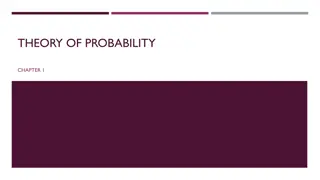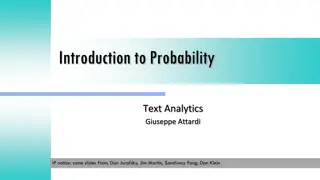Understanding Probability and Calculating Probabilities with Z-Scores
Probability is a number between zero and one that indicates the likelihood of an event occurring due to chance factors alone. This content covers the concept of probability, the calculation of probabilities using z-scores, and practical examples related to probability in statistics. You will learn about the average male's water consumption, probability calculations for scoring above or below the mean, and the application of z-scores in determining the likelihood of specific outcomes. Prepare for quiz questions, analyze distributions, and enhance your understanding of probability theory.
Download Presentation

Please find below an Image/Link to download the presentation.
The content on the website is provided AS IS for your information and personal use only. It may not be sold, licensed, or shared on other websites without obtaining consent from the author. Download presentation by click this link. If you encounter any issues during the download, it is possible that the publisher has removed the file from their server.
E N D
Presentation Transcript
Probability is a number between zero and one. But you can use fractions, decimals, or percent to express probabilities. It indicates a likelihood of an event occurring, that is due to chance factors alone
The average male drinks two liters of water when hiking, with a standard deviation of 0.7 liters. You are planning a trip for fifty men, and you get 110 liters. What is the probability that you will run out>
dangerous coconuts
Week three study questions 1. For statistics, I won t be asking any questions about sample mean distributions. I will be asking some question from past weeks like these: What is a frequency distribution graph? How would you make one? What does a normal distribution look like? Be able to identify which of two distributions has a greater standard deviation. What is the purpose of calculating a z statistic for an individual score/weight/etc.? (hint: standardizing scores)? What does a positive z score mean? A negative z score mean? What are the three components of a z score? How does standard deviation (dispersion) effect a z score if the mean and the individual score is the same? Here are some practice problems and Kahn Academy Videos: https://www.khanacademy.org/math/ap- statistics/density-curves-normal-distribution-ap/measuring-position/v/z-score-introduction Please see the word document for more practice problems on z scores that is posted on week three. 2. 3. 4. 5. 6. 7. Define probability. What is the probability (due to chance alone) of scoring above the mean? Below the mean? Above one standard deviation above the mean? Above one standard deviation below the mean? Above two standard deviations above the mean? This will definitely be on the quiz: Be able to calculate individual z scores, and relate this to probability of obtaining a particular score (similar to what we did in class). If given a mean and standard deviation for a quiz, be able to answer what is the probability of randomly choosing a completed quiz that is above a certain score. For example, if the mean of a quiz score is 80 points, the standard deviation is four, what is the probability of scoring above 88 points. 8.
8. What gives us more confidence that are sample size will be representative of the population? (hint: sample size, and number of samples!). How does this relate to the law of large numbers ? You should have a good understanding of discrete probability and be able to do the basic problems that we did in class. If you need extra help, I recommend that you watch the following video and practice problems: https://www.khanacademy.org/math/precalculus/prob-comb/basic-prob-precalc/v/basic-probability 10. What is the probability of throwing three heads in a row? Two heads in row, followed by two tails in a row? Assuming a six sided die, what is the probability of throwing two sixes? A three and a five? Two sixes and a four? 11. What is the probability of throwing a heads OR a tail? A two or a five with one die? Etc. etc. etc. 12. What is the gambler s fallacy . Be able to identify this fallacy, and be able explain why an assumption is wrong. 13. What is regression/reversion to the mean? How does this relate to assessing the probability of a hot hand ? 14. Be able to make the correct decision on the Monty Hall problem. What is the probability of winning the car if you switch your choice? What is the probability of winning the car if you don t switch? Do the same calculations, but for five doors. Also for one hundred doors. What is this an example of? (hint: conditional probability!) 15. Describe in your own words, what anchoring is. Give three examples of anchoring. Which system does it? How do you calculate the anchoring index (hint: difference predicted/differences of suggested). How is anchoring related to priming? If you missed out on the lecture, here is some additional info: https://www.youtube.com/watch?v=NFiDdbquWJY 16. In you own words describe the availability heuristic. Which system is responsible for this, and how does it judge the frequency of an event? How does this relate to our perception of risk, versus the true probability of an event occurring? For more information: https://www.youtube.com/watch?v=2_wkv1Gx2vM 9.
What does Haidt mean by the emotional dog and its rational tail? Review the differences between is and ought , rationalists and intuitionists. Be able to put various people, disciplines, and ideas in the boxes that we made in class, and be able to justify your choices. Compare and contrast Glaucon and Socrates, in their view of truth and reputation. Do you think we are Glauconian? Should we/ought we be Glauconian? Is it virtuous to be Glauconian? Answer this for yourself, and be prepared to put your answer on a quiz if asked. Be able to articulate mike s theory of the is-ought gap. What role does reason play in crossing the gap? What is an ethical framework/ethical theory? What role does reason and intuition play in choosing which ethical framework to use? How is this compatible with Hume? Be able to identify normative arguments that use the following ethical frameworks to go from is to ought : virtue ethics, deontology, and consequentialism. What is a moral agent ? What is a recipient of an action, and why is this important? What is the circle of moral concern ? How do these ethical theories relate to the agent , action , consequence ? Here is some more background on these ethical frameworks: https://www.youtube.com/watch?v=cfSXUPrIC_4 https://www.youtube.com/watch?v=hACdhD_kes8 https://www.youtube.com/watch?v=-a739VjqdSI https://www.youtube.com/watch?v=8bIys6JoEDw&list=PL6-LHoXyQLZ4Ze-J1S3yI6mHbCxIMBSsQ Be able to write a sentence or two of what you learned about virtue ethics and politics from John Wood Jr.























